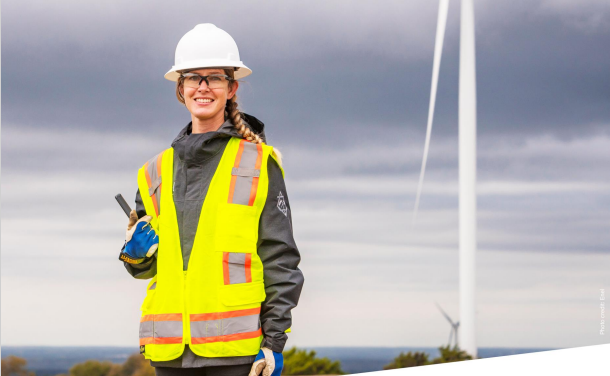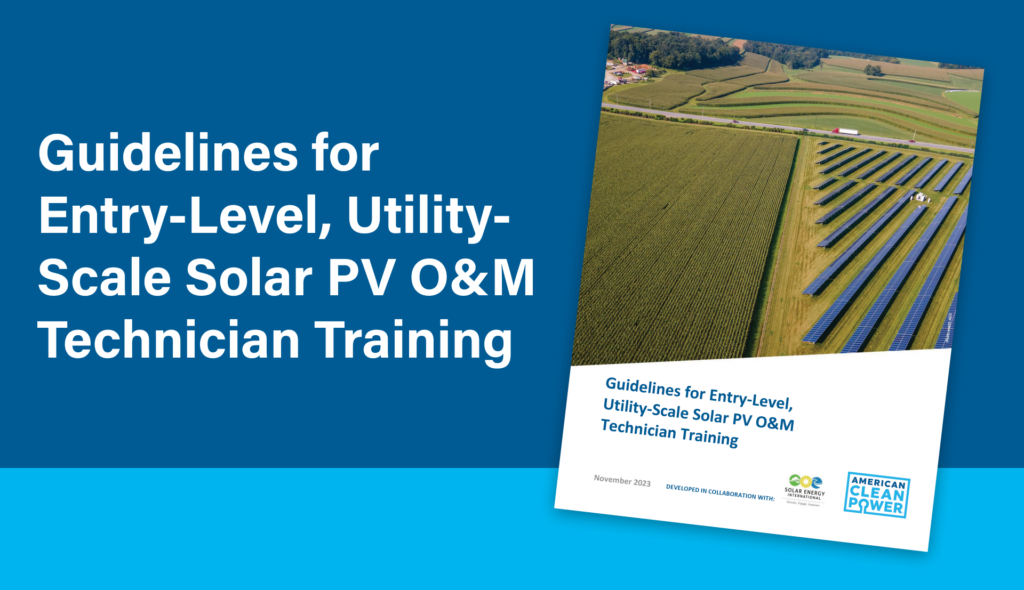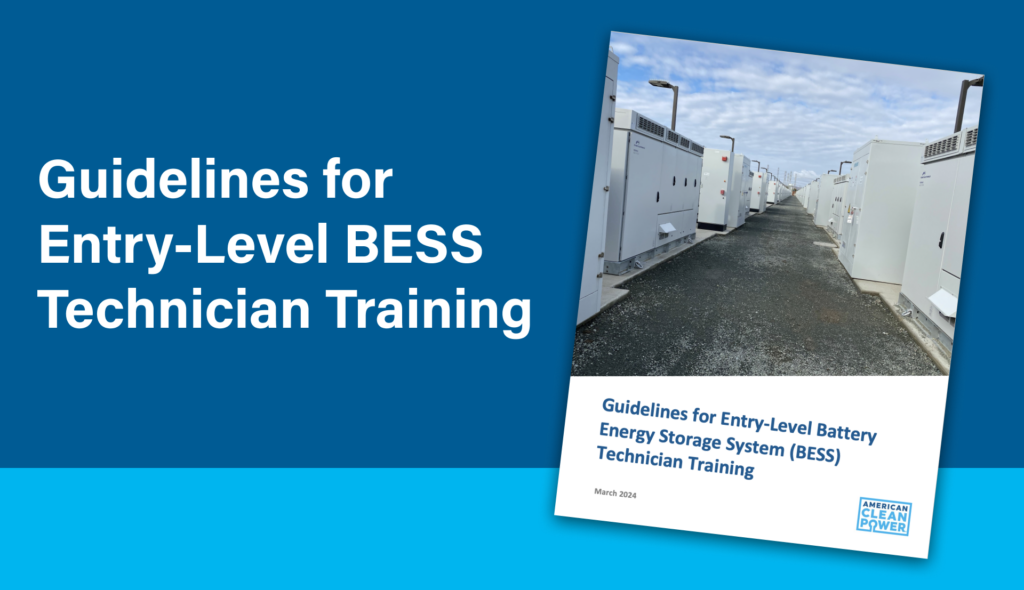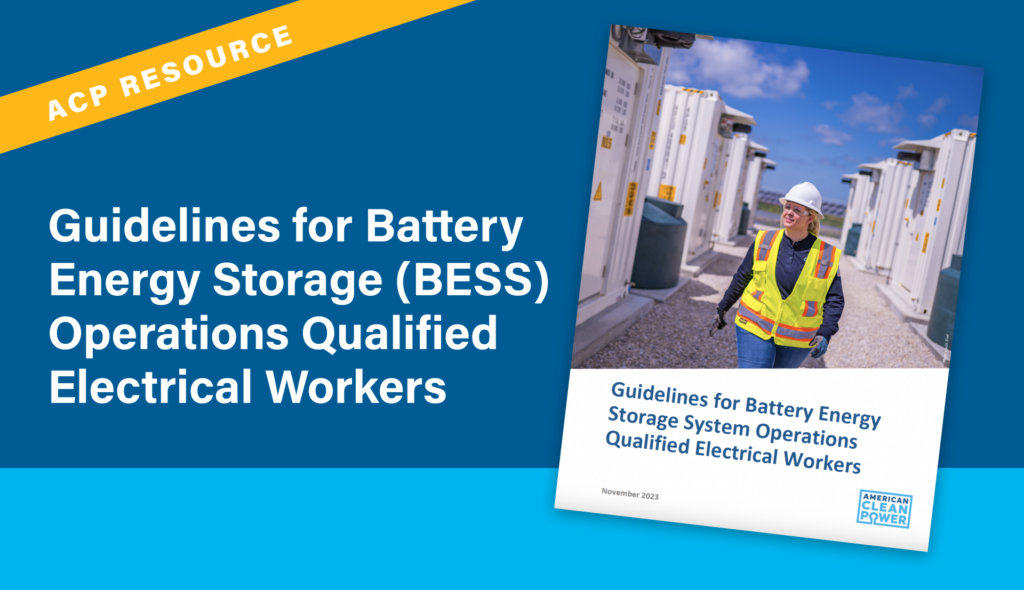Building, operating, and maintaining any power generation project requires a high level of electrical safety awareness, training, technical skills, knowledge, and the personal discipline to always act in a safe manner. Wind energy sites are unique in that there are so many tasks to be performed by so few technicians, often without the specializations found in traditional generation facilities. Thus, guidelines have been prepared in cooperation between the members of American Clean Power Association (ACP) and the Global Wind Organization (GWO).
The ACP Entry-Level Wind Technician Guidelines aim to ensure a comprehensive understanding of entry-level requirements for operations and maintenance wind technicians for onshore and offshore wind facilities. The guidelines will help:
- Alleviate the continued pressure on costs and resources
- Reduce bottlenecks in training
- Provide a stable, competent entry level workforce
- Reduce recruitment constraints by knowledgeable entry-level technicians ready for company qualifications and experience
- Decrease training duplication
- Reduce the pressure on recruitment and training
- Prove useful for both construction and maintenance technicians
Download the Guidelines
What Are These Guidelines?
The goal of these guidelines is to provide a clear route for new entrants into the wind industry and guide a person towards the appropriate training for the different job profiles of wind technicians. The Entry-Level Wind Technician Guidelines establish a transparent and valid set of standardized skills for entry level technician roles in the operations and maintenance wind technicians for onshore and offshore wind facilities that meet the ANSI/ACP 5000- 2 Wind Technician Entry-Level Minimum Standard.
FAQs - Wind Technician Entry-Level Training Guidance
Peruse some of our most-popular questions below.
What is the ANSI/ACP 5000-2-2022 Wind Technician Entry-Level Minimum Standard?
A competency standard to serve as the building block for curriculum for prospective or new wind technicians. It assists employers, workforce development and training professionals, academia, and others in understanding the minimum educational and training-related requirements for entry level Wind Energy Technicians. It will outline the minimum requirements for educational and training program’s learning objectives, knowledge, and skills needed for an entry level wind energy technician position.
Where can I find the ANSI/ACP 5000-2-2022 Wind Technician Entry-Level Minimum Standard?
Download from the ANSI website.
What is the difference between the Standard and the Guideline documents?
The Standard sets the expectation on what needs to be taught or learned, while the Guideline helps to establish a more detailed view on how to accomplish the requirements from a training perspective.
How does this impact my training if my company outsources training?
For many companies, outsourcing training is typically used to get technicians trained. The hope is that when training is outsourced, companies will look to training entities that train to the ACP standard and utilize the guidelines in doing so. If GWO training is preferred, the exciting news is that GWO has developed a pathway for adhering to the ANSI Wind Technician Entry-Level minimum standard as a part of this process. For other training institutions, the training curriculum should be expected to have similar alignment with the Guideline to align with the consensus industry standard, ANSI/ACP 5000-2-2022 Wind Technician Entry-Level Minimum Standard.
How does this impact my training if my company manages our own training programs?
Organizations that have developed programs and are already conducting training should have minimal impact. It is recommended a gap analysis be performed on the in-house training and the ANSI/ACP 5000-2-2022 Wind Technician Entry-Level Minimum Standard and Guidelines. Any gaps identified can be considered to add to the organization’s training program to align with the industry standard and guideline. Any organizations meeting the standard or going above the minimum standard would have no change to the training programs they have in place. However, companies with in-house training programs that align with the ACP standard and guidelines may also see a benefit in tailoring their in-house training to company-specific policies, procedures and equipment and instead relying on other training entities to do the basic safety and technical training covered in the ACP materials prior to the company-specific training.
Who is the Global Wind Organisation (GWO)?
GWO is a non-profit association founded and owned by its members – all are globally leading wind turbine manufacturers and owner/operators. GWO members strive for an injury-free work environment in the wind turbine industry, setting common international standards for safety and technical training. GWO published the first version of the Basic Safety Training (BST) standard in 2012 in response to the demand for a recognizable standard in the wind turbine industry. This was followed by the Basic Technical Training (BTT) standard in 2017. GWO has since launched a range of other training standards with address the most common safety and technical training needs of the wind industry’s largest employers.
Why the need for collaboration with Global Wind Organisation (GWO)?
Since GWO already has established Training Standards that are recognized in the wind industry, it made sense to start with their programs as a base and adjust, as needed, for U.S. regulatory and market considerations and needs. To ensure the needs of the industry were met, ACP led a process to understand the variances between the GWO Standards and the North American market. A detailed gap analysis was performed by a working group of individuals from OEM (Original Equipment Manufacturers), Owner/Operators, third-party operators, EPC, and training providers. Identifying the gaps and ensuring that the ACP Guideline would provide information to ensure the ANSI/ACP 5000-2-2022 Wind Technician Entry-Level Minimum Standard. GWO agreed to review and help update some of their training frameworks to support the North American market.
Do we have to go to GWO training to meet the standard?
It is an option but is not required. Organizations can use GWO, other training providers, develop in-house training, or any combination of those that meet the minimum standard and guideline. Organizations or institutions with comparable training programs may use this guideline to establish their own third-party verification to seek recognition as meeting the industry consensus of the ANSI/ACP 5000-2-2022 Wind Technician Entry-Level Minimum Standard. Organizations or institutions should be advised that recognition of this Standard will always be dependent on, but not limited to, the regulatory, contractual, or owner specified requirements for any given site, and cannot be guaranteed though the application of this guideline. Should ACP establish an accreditation program for training entities, then presuming GWO’s training standard is accredited as adhering to the ACP standard and guidelines, then GWO-certified trainers could also be accredited to train to the ACP standard and guidelines. But entities that are not currently GWO-certified may also be accredited as qualified to train to the ACP standard and guidelines.
What is the difference between certification and certificate of completion?
Certification is the action or process of providing someone or something with an official document attesting to a status or level of achievement. This would typically include some formal testing whether passing a written examination or in person practical validation by a certifying instructor. Certificate of Completion is simply attending a course and gaining credit for participating. These are two particularly important distinctions and, in most cases, since there is no standardized testing to ensure knowledge and terminal objectives are met, many training certificates are certificates of completion. This is something to verify with your training providers.
What is accreditation as it applies to training centers or training providers?
Accreditation is the process of officially recognizing a training center or provider as having a particular status or being qualified to perform a particular activity via an established audit process (i.e., ISO or the International Standards Organization). GWO accredits training providers by ensuring they meet specific requirements per their training framework. ACP is in the process of determining the accreditation process for the ANSI/ACP 5000-2-2022 Wind Technician Entry-Level Minimum Standard and Guidelines, to include future solar and energy storage standards.
What is the difference between Certification and Qualification?
As mentioned above, there is a specific difference between certification or certificate of completion and qualification. Qualification is determined by the employer, and thus the employer should have processes in place to validate the skills, knowledge, and competency to meet the requirements to qualify individuals for tasks, work scopes, or job roles.
How do the ACP Micro-credentials align with this?
Most training is incomplete without demonstrated proficiency or competency for qualification. Per 29 CFR 1910.269(a)(2)(viii) The employer shall ensure that each employee has demonstrated proficiency in the work practices involved before that employee is considered as having completed the training required by paragraph (a)(2) of this section.
29 CFR 1910.9 (b)Training. Standards in this part requiring training on hazards and related matters, such as standards requiring that employees receive training or that the employer train employees, provide training to employees, or institute or implement a training program, impose a separate compliance duty with respect to each employee covered by the requirement. The employer must train each affected employee in the manner required by the standard, and each failure to train an employee may be considered a separate violation.
Micro-credentials are a tool and mechanism to ensure employers have the tools to validate competency and proficiency and would be managed by the employer during the qualification phase. ACP has published 30+ micro credentials and plans to add additional ones throughout the year here.
How does this relate to apprenticeship requirements or programs?
Apprenticeship is a large consideration in terms of industry standards. This guideline could support the future development of an apprenticeship program for organizations or associations.
What is the definition of an Entry-Level Wind Technician?
A wind technician is a broad term that can be used to describe a worker that performs tasks on a
wind turbine and system in the wind energy industry. Typically, the tasks and competencies
would be the following (actual scope and definition may vary by company):
Perform:
● Climb towers >250ft multiple times/day while wearing 25+ lbs. of climbing gear
● Awareness of and the ability to follow all health and safety and operating procedures.
● Participate in daily job task planning activities as it relates to their safe performance of tasks.
● Write (some using computer) routine reports and correspondence. Maintain service logs and
monitor turbine performance.
● Follow written procedures and equipment manuals.
● Collect turbine data for testing or research and analysis.
● Interact with stakeholders as directed by manager and ensure safety.
● Use and must be familiar with a variety of personal protective equipment (PPE) such as
safety harnesses, clothing, glasses, helmets, and shoes.
● Hoisting and rigging.
● Interpreting weather impacts on safety and preparedness.
● Perform rescue operations in emergency situations.
May assist under the supervision of a Qualified Electrical Worker (QEW) in:
● Safe operation and performance of scheduled and unscheduled mechanical, electrical, and
hydraulic maintenance activities for wind turbines.
● Replacement of major turbine components (e.g., generators & gearboxes).
● Identification of failures, faults, and problems, and implementation of corrective actions.
● Conducting acceptance and performance tests on systems and equipment following planned
maintenance and outages.
● Electrical system operations, maintenance, and repair.
● Activities in tight or small, and near hazardous energy sources
Join American Clean Power
Elevate Your Business with Insider Access:
- Policy Direction: Your voice in critical industry discussions.
- Exclusive Networking: Learn directly from key players in clean energy.
- Insider Information: First-hand access to policy insights and premier events.
- Advanced Tools: Our proprietary data at your fingertips to drive growth.
Act now to become a defining part of clean energy’s future.
Stay informed
Subscribe to American Clean Power and receive the latest clean energy news, policy updates, and opportunities to get involved.





